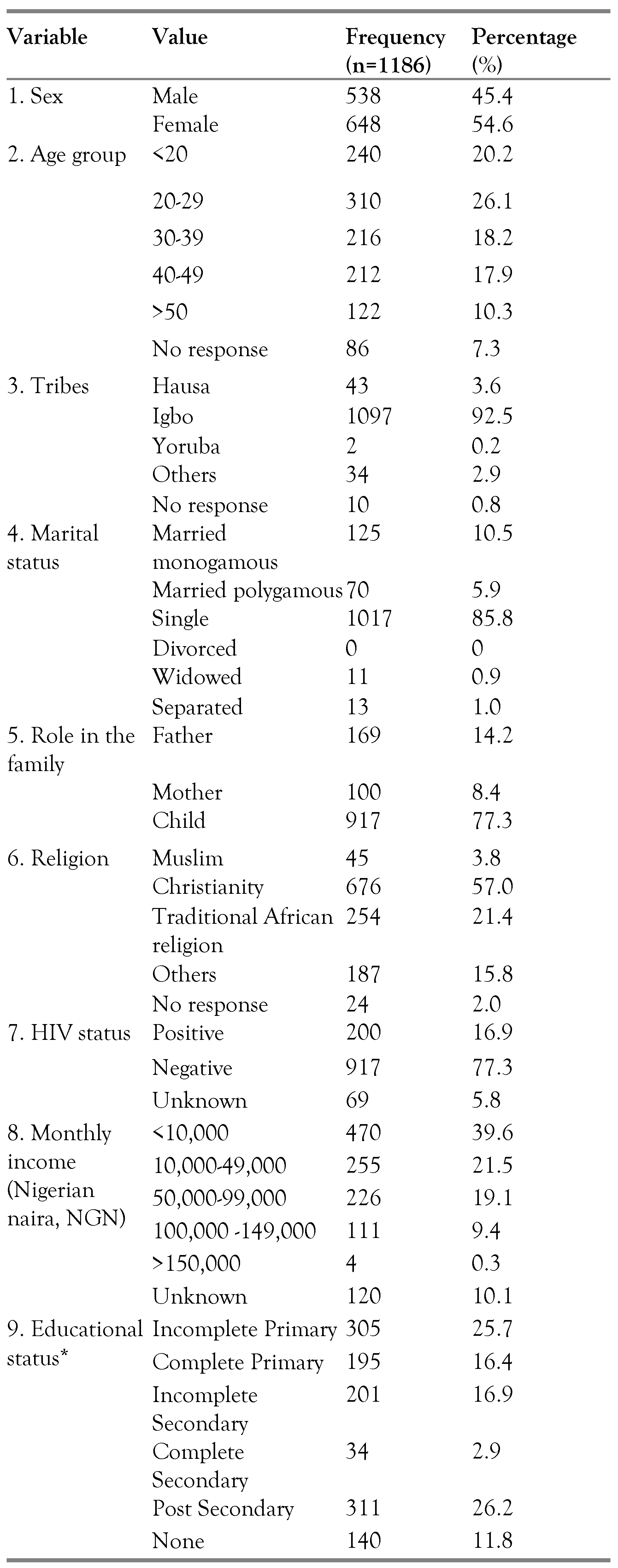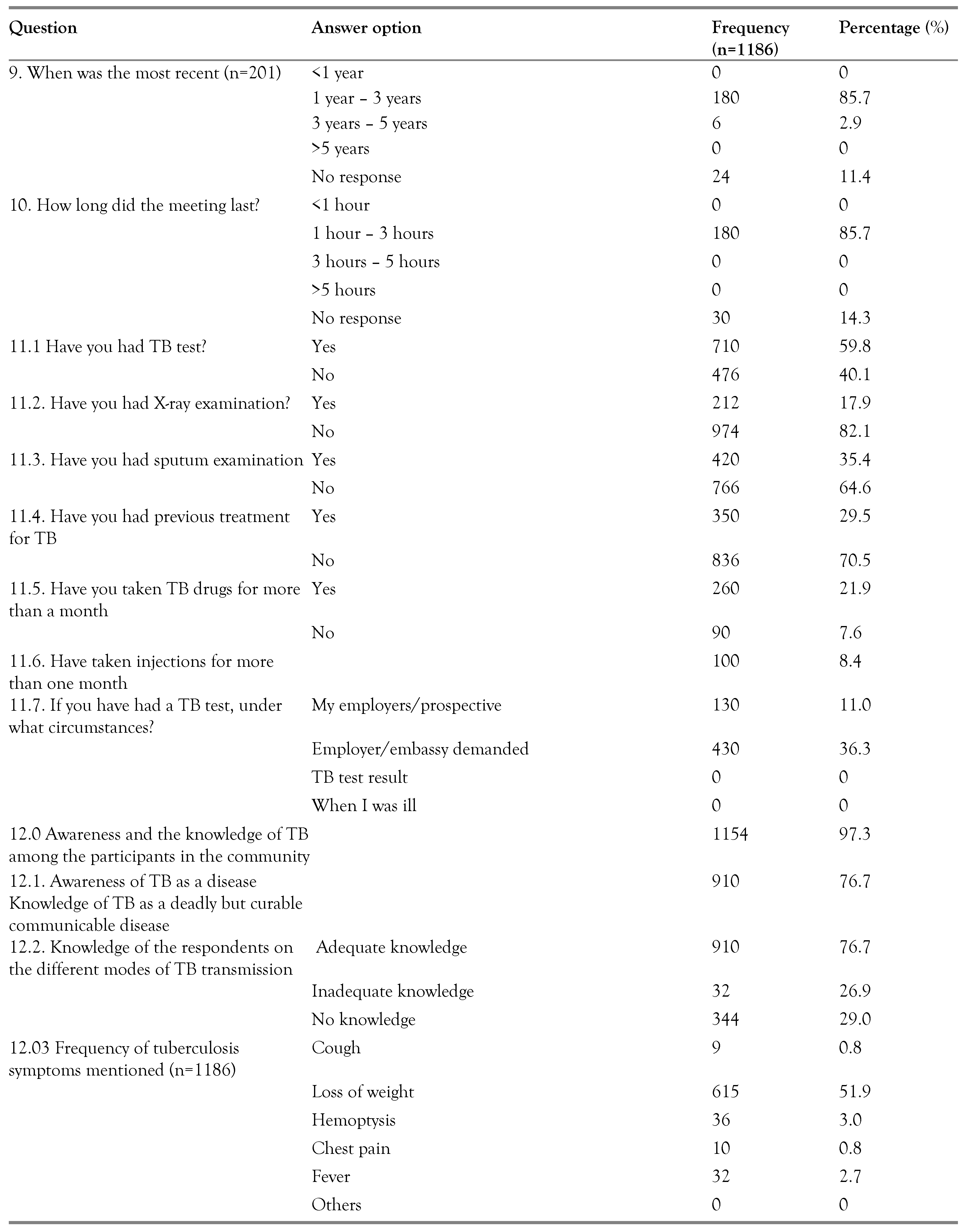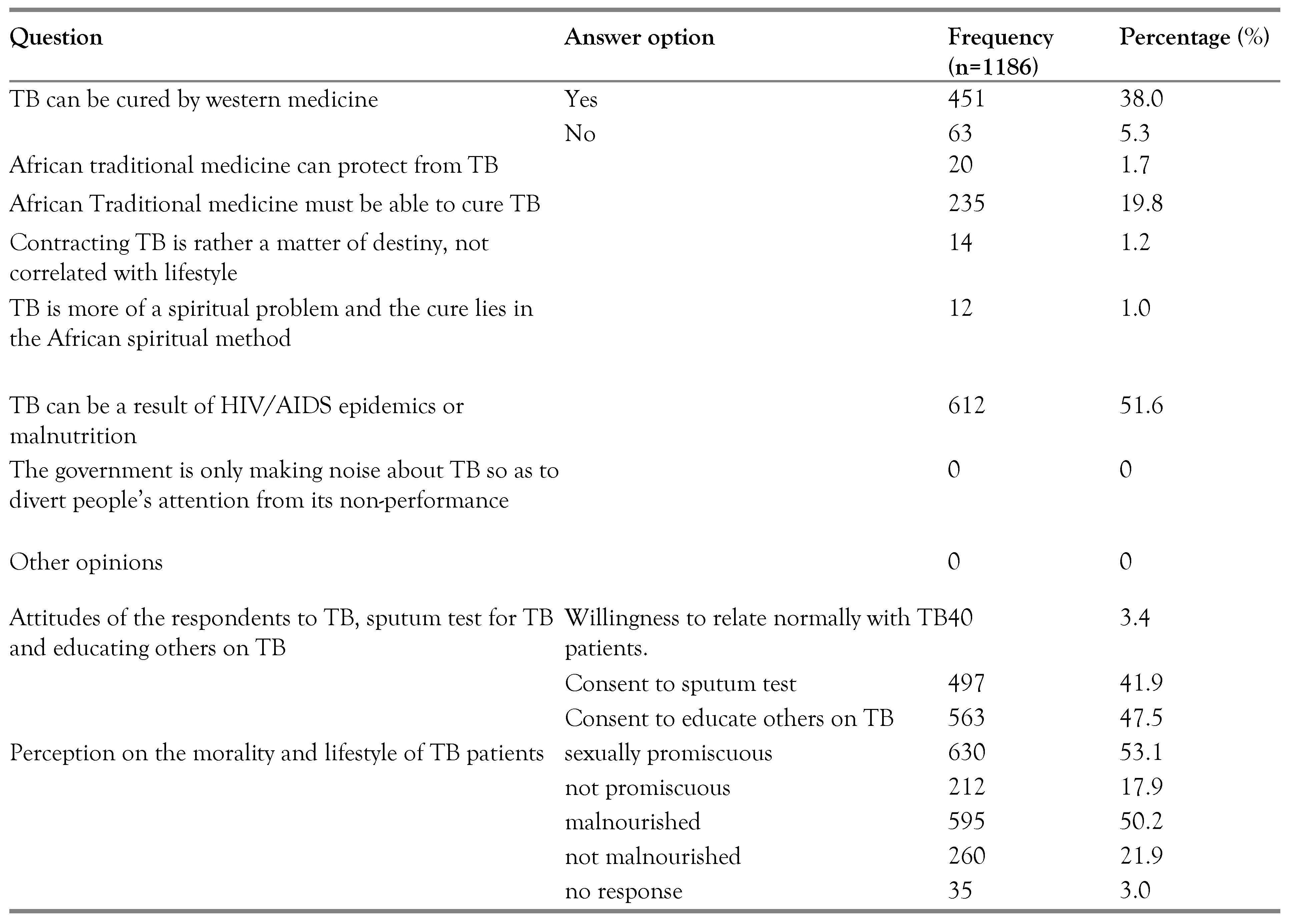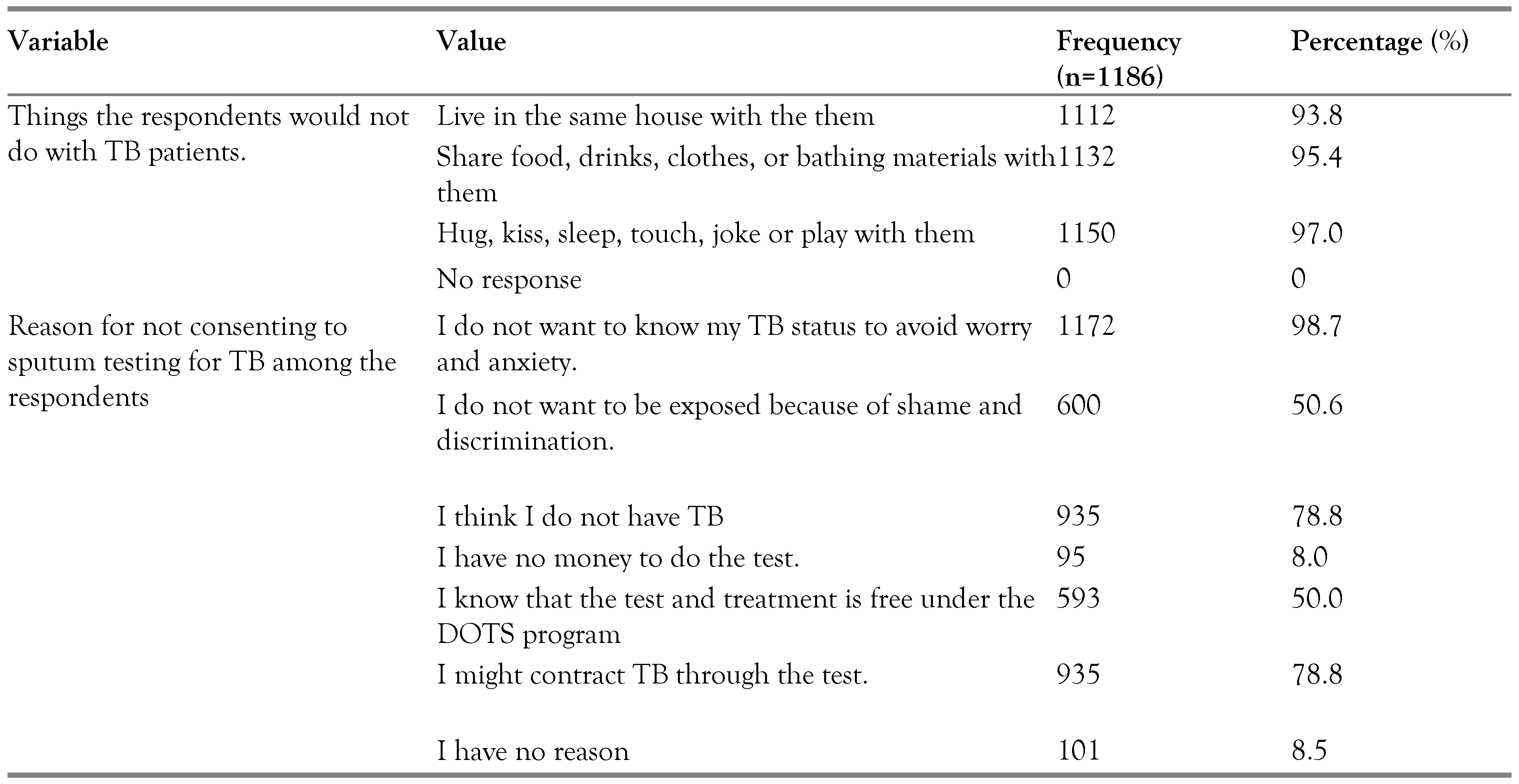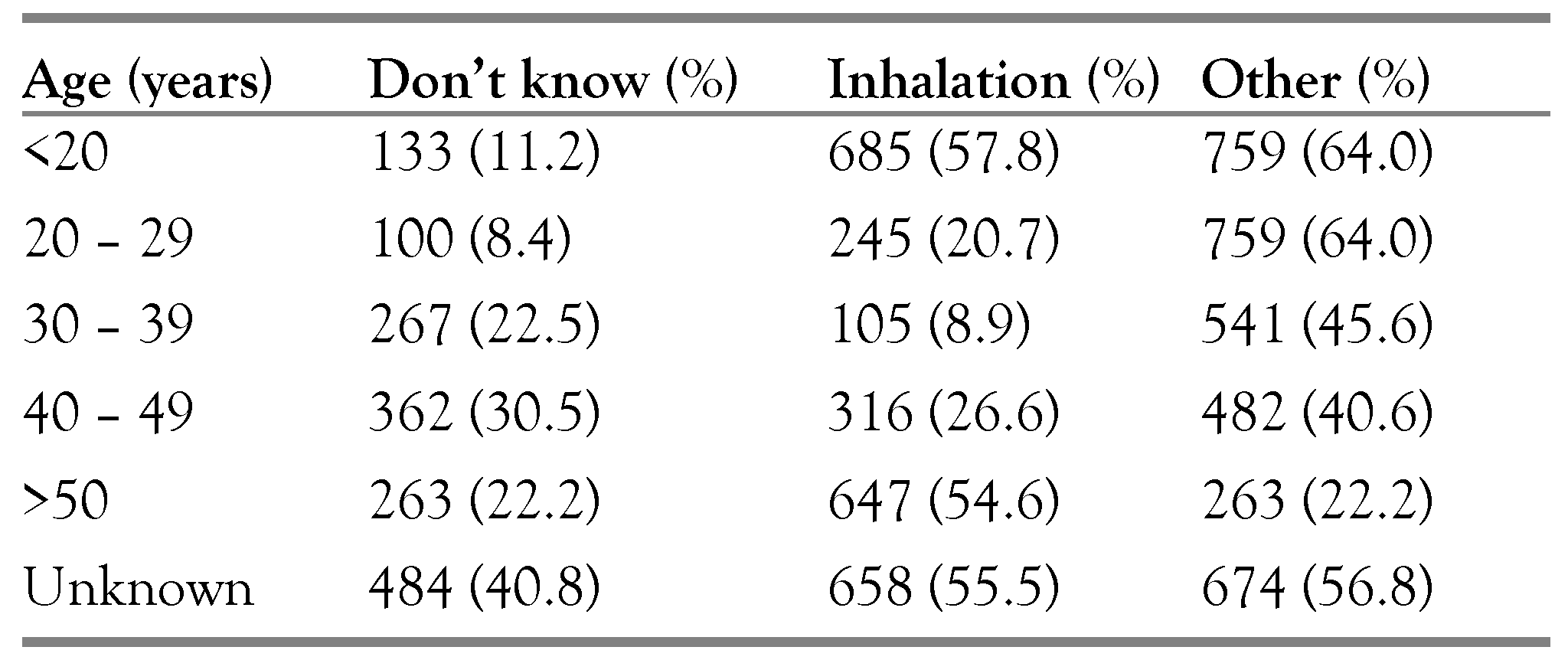Introduction
Community based interventions have long been linked to tuberculosis (TB) control efforts. Effectively treated and cured patients living within their home communities are often the best advocates for TB services and may become the drivers of social mobilization to support TB control. While many community-based programs have been developed by private non-governmental organizations, community approaches particularly for active case finding and TB treatment and support have been easily incorporated into public sector programs. There is need for evaluation of the most effective strategies for scaling up TB treatment, including directly observed treatment short-course (DOTS) implementation through community-based programs [
1].
Community studies are also useful for revealing people’s perception of health services. Findings from social and behavioral research in the community can then be used to eliminate those practices that may discourage the poor and other vulnerable groups from seeking diagnosis and treatment.
One particular concern is stigmatization within communities. Stigma towards TB exists to differing degrees in most countries and may be particularly problematic among hard-to-reach populations. Staff attitudes and beliefs can reinforce stigma through their own practices and interactions with TB patients, as is the example of emphasizing the importance of safe disposal of sputum at the expense of conveying the message that modern treatment rapidly renders a patient non-infectious [
2].
It is uncommon to see health professionals wearing surgical masks in the presence of TB patients. TB in Nigeria is a country-specific public health problem causing local and global concern. Basic and applied scientists specializing in this area are still few. The Nigerian society by virtue of infrastructural development and government presence can be divided into two broad categories of settlements: urban and rural. The urban areas have decent accommodation, electricity, good roads, hospitals and most employers of labor are located there whereas the rural areas lack all facilities mentioned above and where any exist, they represent shadows of what is available in urban areas [
3].
The rural areas are greatly and painfully neglected in TB prevention and care. Most of these areas lack functional hospital facilities and staff to care for TB cases and most non-governmental organizations (NGOs) who carry out enlightenment campaigns are based in the cities. The rural areas also require the establishment of voluntary counseling and testing centers as the majority of the country’s population are rural dwellers. Most rural communities, due to lack of awareness occasioned by non-impact of government policies and activities of NGOs, strongly regard TB patients as people on the sure pedestal of death, hence, they strongly stigmatize this category of persons.
In some cases, patients are denied family care and starved while some are given poisonous concoction for a faster “relief” of death. Educating the population on the consequences of TB, the mode of transmission and informing them of the preventive measures, are all necessary to change the existing negative social norms and enable better behavior for a healthier and more disciplined society.
Environmental health messages not related to TB prevention are often quoted out of context. Immunization as prevention measure against TB is poorly understood. It is recommended that TB control programs focusing on people’s participation and exploitation of locally available resources first raise the general understanding of the mechanisms of TB transmission. Awareness can be increased further through the schools by incorporating TB prevention mechanisms into the school curricula. For now, education is the only prophylaxis against TB. We performed a study to evaluate education on the mode of transmission and other important aspects of TB in the rural communities. This will help to institute appropriate health education programs in the areas where information is lacking.
Emphasis on health education on the various modes of transmission of TB will satisfy the special need to educate the people on the implication of the disease in order to discourage stigmatization of patients [
4].
This study also aimed to determine the level of knowledge, attitude and behavioral practices (KABP) of people towards TB in a rural Nigerian community [
5] while evaluating the level of knowledge of TB in different sections of the society in the community, including the medical community. It evaluated the attitude and behavioral practices of the medical community members towards TB and also the awareness of TB patients regarding their disease.
Therefore, in order to gain insight into the level of awareness of the population of Aboh Mbaise Local Government Area (LGA) of Imo State in South-East Nigeria before embarking on a community based intervention strategy, this TB-KABP survey was conducted in the villages in the community where health institutions stakeholders in the community have reported the occurrence of pulmonary tuberculosis [
6]
. The aims of this survey were to assess and document the knowledge of pulmonary TB, symptoms of TB and preventive measures, to assess which preventive measures were practiced and to establish which age group had a particular knowledge or lack of knowledge of the disease.Perceptions and practices of the people of the community regarding TB were determined and strategies were identified to mitigate the possible challenges. Information obtained from the results will be disseminated to relevant authorities for the efficient formulation of policies and effective implementation of intervention strategies for the control of TB in Nigeria.
Methods
Study Design
We performed a descriptive cross-sectional study to obtain quantitative and qualitative data on the level of awareness of KABP-TB in Aboh Mbaise local government area (LGA), Imo State, Nigeria. Aboh Mbaise LGA is located in the tropical region of a developing country where TB is known to have a prevalence of 31.2% [
7].
We administered an interview schedule consisting of a pre-tested structured interviewer-administered questionnaire, together with in-depth interviews and focus group discussions consisting of 67 questions (mostly open-ended) in adults interviewed in houses randomly selected and identified. All males and females were interviewed in the identified houses. The questionnaire sought to ascertain the respondents’ level of awareness and attitude to TB and TB patients, their readiness to go for laboratory tests and health seeking behaviors, together with their perceptions on the morale of TB patients and whether they have educated others about the disease. The questionnaire and interviews/discussions were carried out by health workers previously trained in questionnaire administration techniques. We also performed a walk-through survey, to determine the housing conditions of the respondents.
Target Population
From the target population consisting of all the people in the LGA, we randomly selected a number of houses. We collected data on their knowledge, perception and practice/utilization of the knowledge they have about TB in the community, age group, educational status, marital status, monthly income, etc.
Sampling Procedure and Sample Size
With a calculated sample size of 1186, participants were recruited into the study using the multi-stage sampling technique. In stage one, one town was chosen from one LGA by simple random sampling, employing simple balloting. In stage two, the list of villages in the town was stratified into 9 using the number of villages as a stratifying factor. In stage three, 16 households were selected per village in the town using simple random sampling, also employing simple balloting out of which 1168 participants were recruited for the study. A total of 16 households multiplied by 9 villages in the town gave 146 households. It is estimated that a household in the area have an average of 8 people including husband, wife and children. The 146 households were multiplied with 8 people to give 1168 participants. A total of 18 additional participants were added (two per village in view of possible attrition) to round up the sample size to 1186 in order to make up for the sick or uncooperative respondents or even those that may not respond to the questions due to ignorance or confusion. Interviewing of the respondents was facilitated using full explanations and local interpreters for easier assessment.
Thus, the multi-stage sampling procedure was used, entailing the use of random sampling and systematic sampling among the different sections of the society in the rural community. This technique was adopted to select a sample population from each village, ensuring that there were representatives from each village.
Data Collection
Quantitative data was collected from the participants using structured questionnaires while the qualitative data was collected by conducting focus group discussions and key informant interviews with opinion leaders in the community, health workers and other people from all sections of the community, including TB patients. Quantitative data included most information on socio-economic and demographic characteristics of the participants while qualitative data included the reactions and perceptions of people, together with the utilization of knowledge, perceived impact, how respondents rated their knowledge, potentials and resources of the participants.
A pre-coded semi-structured questionnaire was administered to each of the family members in each village household. The questionnaire was pre-tested in 9 households, one from each of the nine villages in the town. Modifications to the questionnaire were performed as necessary to ensure accurate facilitation of the data analysis procedure.
Data Analysis
The demographic data, awareness and the knowledge of TB, attitudes to TB, TB sputum test, modes of transmission and the perception of the people as well as the morale of TB patients were recorded and the data obtained were entered into a computerized database and analyzed with Epi Info 3.2.
The developed evaluation questionnaire was pilot tested for comprehension and clarity. All ambiguity in the questionnaire was then addressed before being used on the selected sample. Data was collected in each village (zone) by a consultant who was involved in the development of the tools as well as a research assistant and health workers who were trained in the use of the tools. The data collected were safely and confidentially stored.
Data analysis focused on the evaluation of KABP-TB based on participant assessment and reports, correlates of changes reported in the use of knowledge about TB, reported improvement in KABP-TB, suggestions from participants on how to improve for greater impact, the health facilities’ assessment of the participant’s KABP-TB. Data generated from both the qualitative and quantitative methods were used to complement each other and to bring more light on the study objectives.
Transcripts were individually and collectively analyzed to identify variable transformations despite the financial, human and infrastructural limitations of the project. Double entry and random checking techniques were used to ensure consistency of data entered. Data were presented in the form of frequency tables.
Results
We applied the questionnaire to 1186 people in the designated rural households. The demographic characteristics of the respondents are presented in
Table 1. Ages ranged from 18 to 67 years with 20.2% aged 18 years. Most respondents 26.1% (310) belonged to the age group 20-29 years.
We identified a preponderance of females (54.6%). Most of the participants were from the Igbo ethnic group and Christianity was the predominant religion in the community.
The results showed that 97.3% (1154) of the participants had prior knowledge and awareness about TB as a disease, 51.6% (612) believed that TB can be a result of the HIV/AIDS epidemics or malnutrition, and 38% (451) believed that TB could be cured by Western medicine. The unwillingness of respondents to relate with TB patients was generally high (97%, 1150), even where levels of awareness and knowledge were equally high.
In the study area, Aboh Mbaise Local Government Area of Imo State, South Eastern Nigeria, both levels of awareness and knowledge of TB were equally high. Consent to laboratory testing for TB and educating others was also very high. Adequate knowledge of the modes of the transmission, the availability of free diagnosis and treatment of the disease appeared to be very high.
While only 53.1% (630) of the respondents perceived TB victims as sexually promiscuous, others believed that TB is spread when others are infected with “TB cough”. It is therefore imperative to institute appropriate education programs on TB in new and creative ways. Accurate and relevant information on TB among adults could discourage stigmatization and misconception about the disease. Free screening tests will also prevent the spread of the disease.
Table 2 summarizes the level of knowledge and awareness regarding TB among the respondents in the community. Awareness was very high and adequate knowledge of TB as a deadly communicable disease followed the same pattern. Willingness to relate normally with TB patients was generally low while levels of awareness and knowledge are very high. Consent to sputum test was not high.
Cough, the most common presentation of pulmonary TB was mentioned first in 68% (806) of the respondents’ answers. Loss of weight was mentioned by 51.9% (615) of the respondents while hemoptysis was mentioned by 55.6% (660) of them.
Only about 55% (652) of the respondents could list 3 or more symptoms or signs of the disease. Other responses regarding TB symptoms included: headache, body ache, joint-muscle pains and loss of appetite.
The attitudes of the respondents towards TB patients, sputum test for TB and educating others on TB in the community are presented in
Table 3.
In
Table 4, the various reasons mentioned by respondents for not consenting to take the sputum test for TB were summarized. About 78.8% (935) would not take the test because of fear of contracting the disease. This may be an indication of the level of ignorance about the mode of transmission of the disease.
Table 4 also summarizes the things that respondents would not do with TB patients. Almost two thirds 97% (1150) would not have sexual intercourse or sleep with TB patients while 93.8% (1112) would not live in the same house with them.
Table 5 indicates the knowledge of the respondents on the different modes of TB transmission. Lack of knowledge was demonstrated frequently among the respondents. This collaborates with the finding presented in
Table 2 regarding the awareness of the disease. More than half 76.7% (910) of the respondents had no idea of the mode of transmission of the disease.
Most of the respondents (910, 76.7%) said they know the cause of tuberculosis; 27% (320) could not associate the spread of the disease with droplet infection. Other methods of spread suggested by respondents included touch 97% (1150), act of God 1.7% (20), while 3.7% (44) were not able to name any route of transmission.
Concerning cost of TB treatment, 8% (95) of the respondents felt that anti-tuberculosis drugs are expensive while 50% (593) felt that the drugs were not expensive. However, most of the respondents did not know that diagnosis and treatment of TB is free.
Most of the respondents were unaware of the World Health Organization (WHO) directly observed treatment short-course (DOTS) treatment strategy for the control of TB.
Most of the respondents stated that they did not know what caused TB. Among those who said they knew, 57.8% (685) stated that it was caused by inhaling contaminated air, 64% (759) that it was caused by ingestion, 4% (47) stated that it was caused by witchcraft, touch, and act of God. A smaller number of people over 50 years knew that pulmonary tuberculosis was mainly transmitted by inhalation (54.6%, 647). This decreased with ascending age (
Table 5). Knowledge of prevention measures is shown in
Table 6. In the 30-39 years of age group, 64.2% (761) of the study participants believed that environmental measures are preventive measures for the transmission of disease.
Walk-Through Survey
A walk-through survey revealed houses crowded together in compound bands, with small windows, encouraging transmission of airborne diseases. About 65% of the houses in the community had more than 2 people sleeping in a room together. In most cases, the rooms were smaller than 120 square feet, the area ideally recommended for 2 people. Hence, conditions exist in the community for transmission of respiratory diseases including tuberculosis.
Discussion
The estimated prevalence rate of TB in Nigeria, taken as the proportion of respondents who had been coughing for more than four weeks at the time of interview was 31.2%. Further microscopic examination of the sputa of those who had been coughing for more than four weeks for Mycobacterium tuberculosis revealed a prevalence of 30.5% by smear technique and culture (unpublished data).
Despite a worldwide campaign coordinated by WHO and many governmental and non-governmental organizations towards prevention, tuberculosis remains a significant public health problem worldwide. Education and information programs have been considered the best available options towards a healthier and disciplined society.
Designing such programs requires the knowledge on the subject matter to determine the nature of the education program and information, education and counseling materials. Our study showed high levels of awareness among the respondents in the community. Among other factors, this may be attributed to intensive screening for TB in patients referred to free government health clinics, chest clinics and DOTS centers as well as reliance on traditional medicine for curing the disease. Other factors include the location of DOTS and diagnostic centers in the vicinity of communities and in the Local Government Area of each state. Workshops, seminars and public lectures on TB are covered by electronic and print media. Lectures are freely given to patients at primary health care centers.
Adults from higher socio-economic classes have better knowledge of TB compared to the low level of awareness in adults of middle or lower socio-economic status [
7]. Adequate knowledge of the nature of the disease may also influence the attitude of the individual towards TB patients. For instance, a high percentage of adults with knowledge of TB were also unwilling to relate normally with the patients. Such non-caring attitude towards TB patients could greatly decrease their welfare and increase their psychological trauma due to discrimination. It was surprising to note that a large part of the respondents (41.9%) would consent to sputum test for TB.
However, 50% of the respondents were unaware that diagnosis and treatment of TB is free of charge under the DOTS program. Therefore, awareness in this regards has to be created for the community. It is imperative to note that the knowledge of the individual’s TB status could attract appropriate counseling towards TB prevention. We also observed that willingness to educate others on the disease was high among the adults in the community, as were the knowledge of the different modes of transmission and the tendency to adopt appropriate preventive measures.
It is known that inadequate knowledge of the disease promotes stigmatization [
8]. For instance 93.8% of the respondents would not live in the same house with TB patients or share food, drink, clothes, bathing materials (95.4%) or hug, kiss, touch, joke or even play with them (97%). These negative attitudes usually result in stigmatization, which consequently imposes psychological trauma on the victims. Similarly, adequate knowledge of the ways in which TB can be transmitted would correct the perception that TB patients are impoverished (50.2%) or sexually promiscuous (53.1%). Therefore efforts should be intensified in informing the population on the appropriate modes of TB transmission [
9].
Nonetheless, malnutrition and HIV/AIDS [
10] were considered major routes of TB transmission by the respondents. This is also reflected in their decision to avoid sexual relationships with TB victims and to share food or drink with them. Accurate information about TB would reduce unnecessary discrimination against the patients and permit care and love from friends, relatives and the community as a whole.
Public health campaigns to raise awareness about TB can be very effective and are needed more than ever. A truly effective campaign requires local involvement, national leadership, use of the right source of media to reach people, and a sense that the campaign originated within the culture of the community or people rather than being imposed by outsiders. Finding out why people engage in TB risk factor practices is essential for designing campaigns that can deliver on the promise of reducing TB transmission [
11].
Conclusions
There is still a need to educate the majority of Nigerians about the etiology and the appropriate preventive measures against TB. The general public is not conversant with the symptoms associated with pulmonary tuberculosis and this ignorance is most prevalent where the knowledge about preventive measures matters most, that is in the rural areas where approximately 70% of the people live [
12].
Environmental health messages not related to tuberculosis prevention are often quoted out of context. Immunization as a preventive measure against TB is poorly understood [
13,
14]. It is recommended that programs focusing on people’s participation and exploitation of locally available resources be used to first raise the general understanding of the mechanisms of TB transmission [
11].
Awareness can be increased further through the schools by incorporating disease prevention mechanisms in school curricula. For now, education is the only prophylaxis against TB. Education on the mode of transmission and other important aspects of TB in the study area investigated was found to be inadequate. There is therefore an urgent need to institute appropriate health education programs in these areas where information is lacking. There is a special need to emphasize on the various modes of TB transmission and the implications of the disease in order to discourage stigmatization of the patients.
These results should be used to orient tuberculosis control programs, especially those aimed at mobilizing people for tuberculosis control and eradication. Information obtained from this study will also be disseminated to relevant authorities for the efficient formulation of policies and implementation of intervention strategies for the control of TB in Nigeria.
